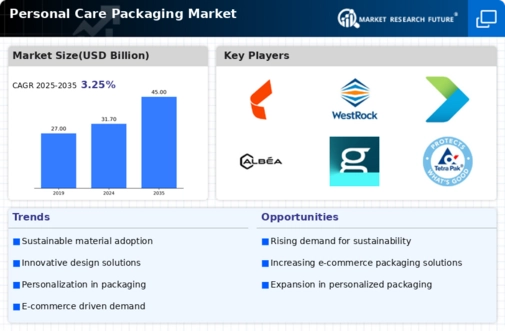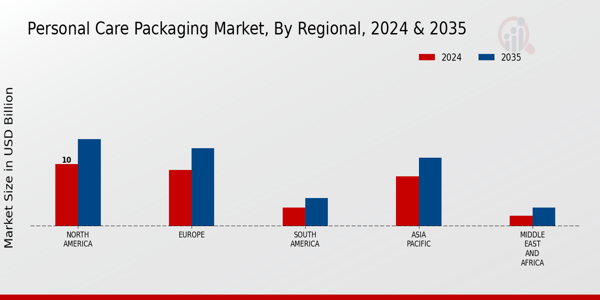Personal Care Packaging Size
Personal Care Packaging Market Growth Projections and Opportunities
The Personal Care Packaging Market is influenced by a host of factors that interactively shape its dynamics and growth path. Some reasons are the rise in consumer demand for creative and convenient packaging that is driving it towards this direction. Packaging plays a crucial role in providing user-friendly and portable options as consumers look for products that conform to their hectic lives. Consequently, personal care packaging has to blend functionality with aesthetics to meet customers’ ever-changing tastes.
The Size of the Personal Care Packaging Market was estimated at USD 29.3 Billion in 2022. The Compound Annual Growth Rate (CAGR) expected for the Personal Care Packaging industry from 2023 to 2032 is 7.4% which will increase its market size from USD 31.4 Billion in 2023 to USD 55.7 Billion.
Innovation in packaging technology also significantly drives the personal care packaging market. Manufacturers are continuously seeking better materials and methods that can enhance attraction and performance of package coverings. The movements are focused on new airless packages as well as smart packing solutions among others, whose primary aim is not only to extend the shelf life of products but offer an exciting experience for users throughout their life cycles at all costs other than financial ones thereby serving multiple purposes including branding and raising product awareness within the particular market segment they serve.
Personal care packaging has been greatly affected by e-commerce boom. In order to remain visually appealing amidst heavy competition on digital marketplace, a package needs to be tough enough during transportation through rail, road, or air modes of shipment(s). For instance, tamperproof features plus secure closures are essential e-commerce-friendly package additions as they help preserve contents’ freshness throughout delivery hence adding value both functionally as well as aesthetically.
This means that consumer demographics and cultural preferences have significant implications for trends in personal care packaging.To make matters more complex, there could be differentiations concerning geographical areas and consumer demographics that may lead to dissimilar preferences for packaging with regard to sizes, aesthetics, and materials. Packaging that speaks to certain cultural things and preferences of a particular target market can be very helpful in the success of personal care products. This is why it is essential for packaging manufacturers to understand the diverse preferences of consumers if they want to stay competitive in the global personal care market.
The personal care packaging market landscape is highly competitive and characterized by constant innovations as well as strategic alliances. These new packagings are meant to give these companies a cutting edge over their rivals hence they invest heavily in them through research and development. Strategic alliances between beauty product producers such as cosmetic companies and packaging suppliers have become quite common today allowing for joint design of packages around brand identity so that customers’ expectations could be met.

















Leave a Comment